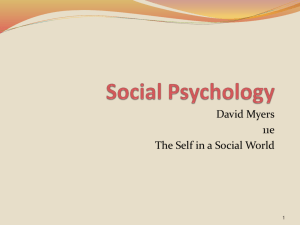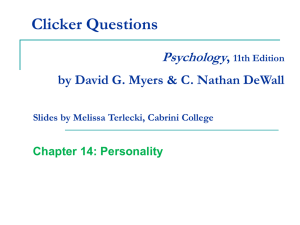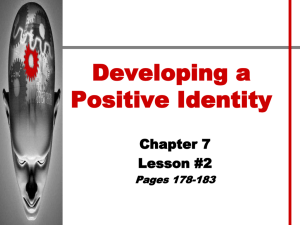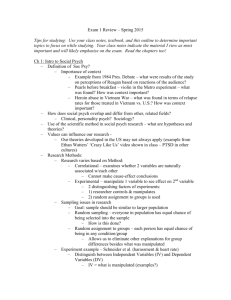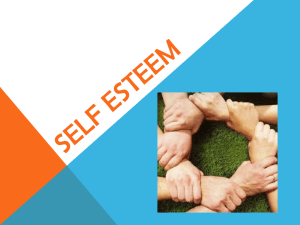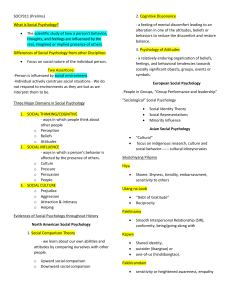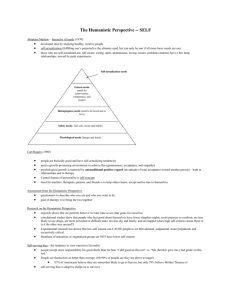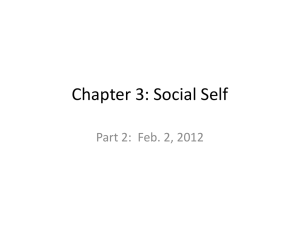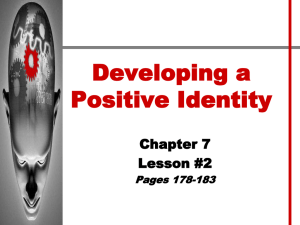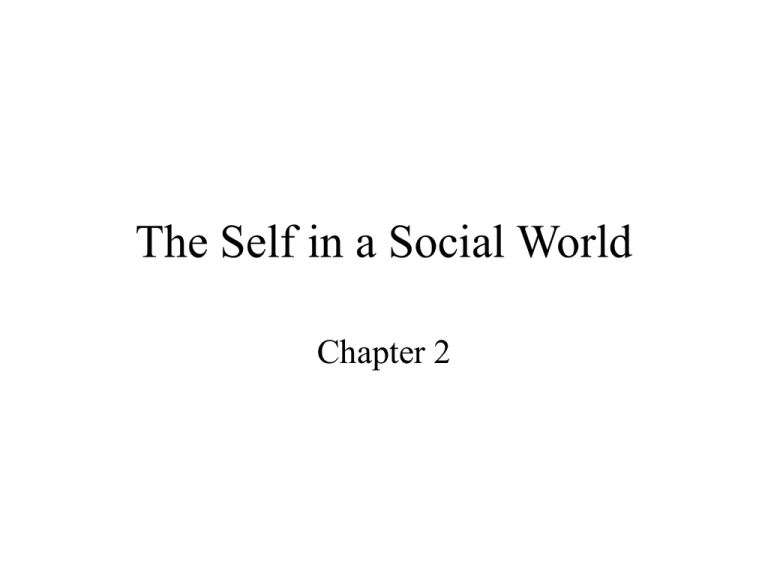
The Self in a Social World
Chapter 2
Self-Concept: Who Am I?
•
•
•
•
•
I am
I am
I am
I am
I am
At the Center of Our Worlds:
Our Sense of Self
• Self-schemas
–
–
–
–
Affect our memory: self-reference effect
Affect our perception/interpretation of others
“Spotlight effect”
Our “possible self-schemas” motivate us
• Positive AND negative
I Am Me; I Am OK
What is Self-Esteem?
• Our overall self-evaluation
• What makes it high or low?
– “Top down” - Which schemas are most
important to you?
– “Bottom up” - Do you already have high selfesteem?
Development of the Social Self
• Genetic influences
• Our roles: Playing to becoming
• Social identity = identity that comes from
group memberships
– Small group surrounded by large group = more
consciousness of that social identity
Development of the Social Self (cont.)
• Social Comparisons
– How do we know we are smart, dumb,
handsome, etc.?
– The pitfalls of comparison
• Successes and failures
• Other people’s judgments
Self and Culture:
Individualism vs. Collectivism
• Individualism and Western culture
– Priority is given to self-goals and identity over
group goals and identity; the independent self
• Collectivism - the interdependent self
• There are variations w/in cultures
• Self-esteem in different cultures
Self-Knowledge
• How well do you really know yourself?
– On one level, very well
– On another level, not very well at all
•
•
•
•
Is it obvious or subtle?
Predicting our behavior
Predicting our feelings
The bottom line: often we are dead wrong,
sometimes we are right on
Perceived Self-Control
• “Self-control operates like muscular
strength…both are weaker after exertion,
replenished with rest, and strengthened by
exercise” (p. 53)
Self-Efficacy
• Sense of competence and effectiveness
• The benefits of self-efficacy (correlations):
–
–
–
–
–
More persistence
Less anxiousness, depression
Healthier lives
More academic success
Higher worker productivity
Locus of Control
• To what do you attribute outcomes?
• Internal versus external
• Which one is more likely to
–
–
–
–
–
–
Do well in school?
Successfully stop smoking?
Wear seat belts?
Use birth control?
Deal directly w/ marital problems?
Make more money?
Learned Helplessness Versus
Self-Determination
• Learned helplessness - “I am helpless
because I have no control over the bad
things that happen to me”
• Langer and Rodin (1976)
• Personal control can affect the health of the
psyche
• The “Tyranny of Freedom”
Self-Serving Bias
• The “culture of low self-esteem” fallacy
• Self-serving bias =
– The tendency to perceive oneself favorably
Explaining
Positive and Negative Events
• People tend to accept credit for their
successes
– esp. in situations that combine skill & chance
• They also tend to attribute failure to
external factors
• The marital version…the student
version…the employee version… the
driver’s version...
Can We All Be
Better Than Average?
• The self-serving bias tends to be esp.
pronounced when comparing ourselves to
people in general
• Subjective dimensions also elicit greater s-s
bias than objective behavioral dimensions
• We tend to place greater importance on the
things we feel good at
Unrealistic Optimism
• Pervades our thinking
• Increases our vulnerability
–
–
–
–
Unsafe sex
Smoking
Seat belt use
Marriage!
• BUT… it promotes self-efficacy, health,
and well-being.
• We need a bit of “defensive pessimism”
False Consensus and Uniqueness
• False consensus effect: the tendency to
overestimate the commonality of one’s
opinions and one’s undesirable or
unsuccessful behaviors
• False uniqueness effect: the tendency to
underestimate the commonality of one’s
abilities and one’s desirable or successful
behaviors.
Self-Esteem Motivation
• Why the self-serving bias?
– Multiple motives
– Cognitions are influenced by motivations to
protect and/or enhance self-esteem
The Dark Side of Self-Esteem
• Low SE is associated w/ higher risk of
depression, drug abuse, and some types of
delinquency
• Teen gang leaders, extreme ethnocentrists,
and terrorists tend to have higher than
average SE.
• Does ego really = low self-esteem?
Impression Management
• Self-presentation is how we act or behave to
create a desired impression on another
– Consciously or unconsciously
– Self-handicapping
– False modesty
• Self-monitoring is the cycle of monitoring
one’s behavior, noting how others react, and
adjusting one’s behavior accordingly.
• Janet Swim and Lauri Hyers (1997)
– Participants were presented with this hypothetical
situation: You and 3 others are discussing whom to
select for survival on a private island. One man in this
group makes a series of sexist comments such as “I
think we need more women on the island to keep the
men satisfied.” How did the student participants react to
his remark? 5% said they would ignore his comments
or wait to see how the others reacted. Then, the
experimenters engaged others in discussions where a
male confederate made such comments. What percent
actually said nothing?
56%
• “The pedestrian had no idea which direction to go so
I ran over him.”
• “A truck backed through my windshield and into my
wife’s face.”
• “The guy was all over the road. I had to swerve a
number of times before I hit him.”
• “I had been driving my car for 40 years when I fell
asleep at the wheel and had an accident.”
• “To avoid hitting the bumper of the car in front, I hit
the pedestrian.”
• “The telephone pole was approaching fast. I was
attempting to swerve out of its path when it hit my
front end.” :-)
On a sheet of paper write down 10
antonym pairs such as
good - bad
Rain - sun
Circle the pairs where the positive antonym was listed first
The Polyanna Principle: In perception,
language, memory, and thought, the pleasant
predominates over the unpleasant.


